Golfo de California – Gulf of California – Sea of Cortez – There are usually several names to choose from for the places and sea areas here. Many are also reminiscent of North America. We are in the Bahia San Francisco, not to be confused with the Bahia San Francisquito, there is the Bahia de Los Angeles and in general the names here are very Christian: Isla Espiritu Santo, Bahia Concepcion, Santa Maria, Magdalena Bay, Isla Angel de la Guardia, Asuncion, Todos Santos. There are also several saints: Cabo San Lucas, Santo Tomas, San Martin, San Felipe, San Carlos (twice, on the east side of the Gulf and on the Pacific side of Baja California). So it’s not surprising that we went from Santa Rosalia to San Carlos 😉
After Christmas 2021, we first went out of the bay with the spot for fast internet to Puerto Escondido. There you can tap into the marina’s WiFi from the lagoon. There are buoys there, but they are quite expensive (about US$50 for us). We only spent one night there and else anchored on the opposite Island of Danzante in Honeymoon Cove. If you leave a line to the south clear, you can still benefit from the internet spot in Candeleros Bay. (This as information for other sailors.) Connection to the internet plays a role in the modern globetrotting scene. In the past, after a long voyage on the high seas, the crew would say “land in sight”, but nowadays they gather on deck, hold up their mobile phones and king or queen is who can shout first: “I am online!!!!”.

In Puerto Escondido we met up with the Carry On again. They had just unloaded guests and were in need of a rest. Guests are welcome on board, but they bring a lot of extra work and change the daily routine to which one has become accustomed by now. Together we took a taxi to the next bigger town, Loreto, in the all-important search for a supermarket. There are a few there. The one we found was medium sized and we could buy fruit and vegetables.


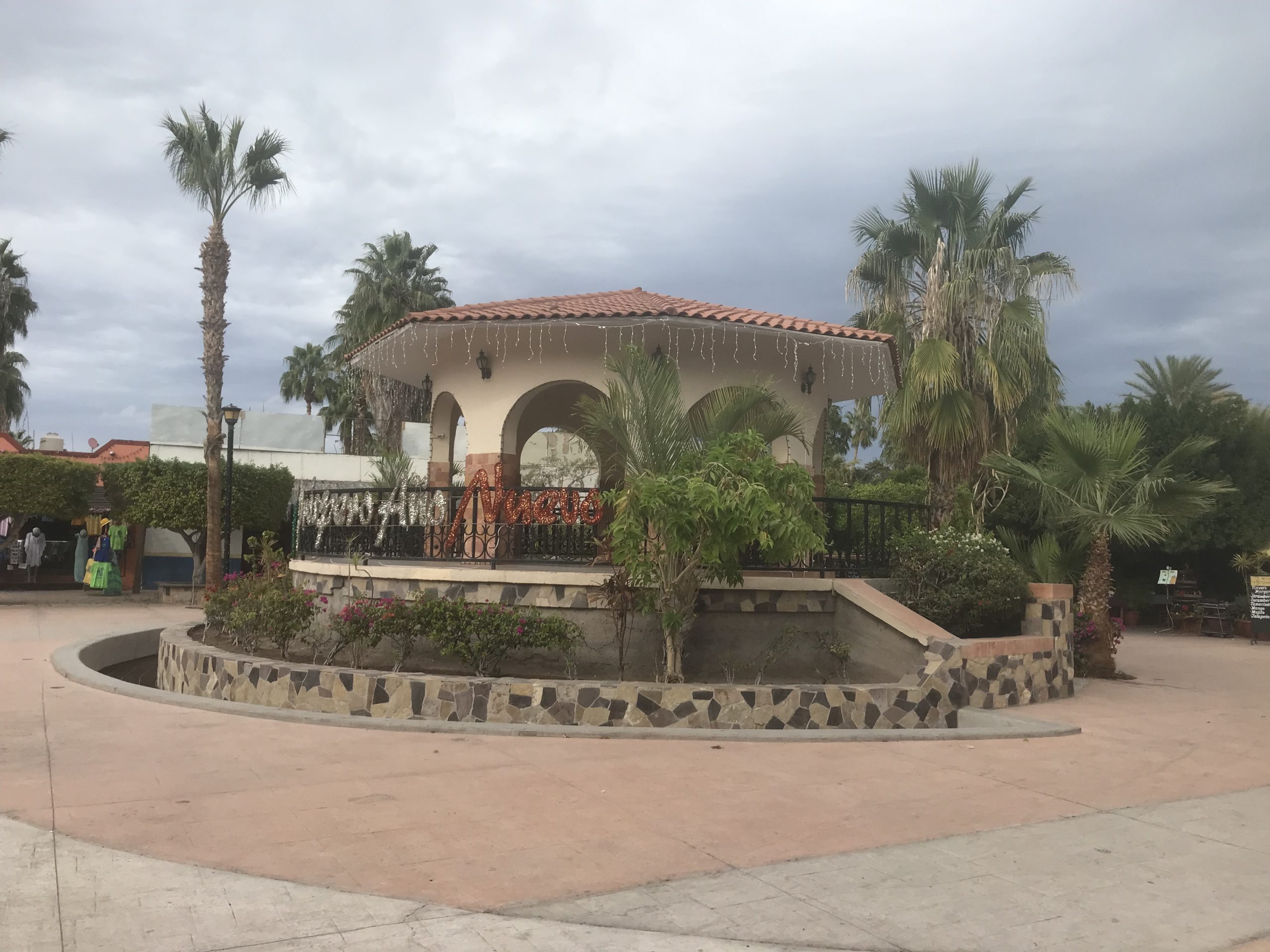

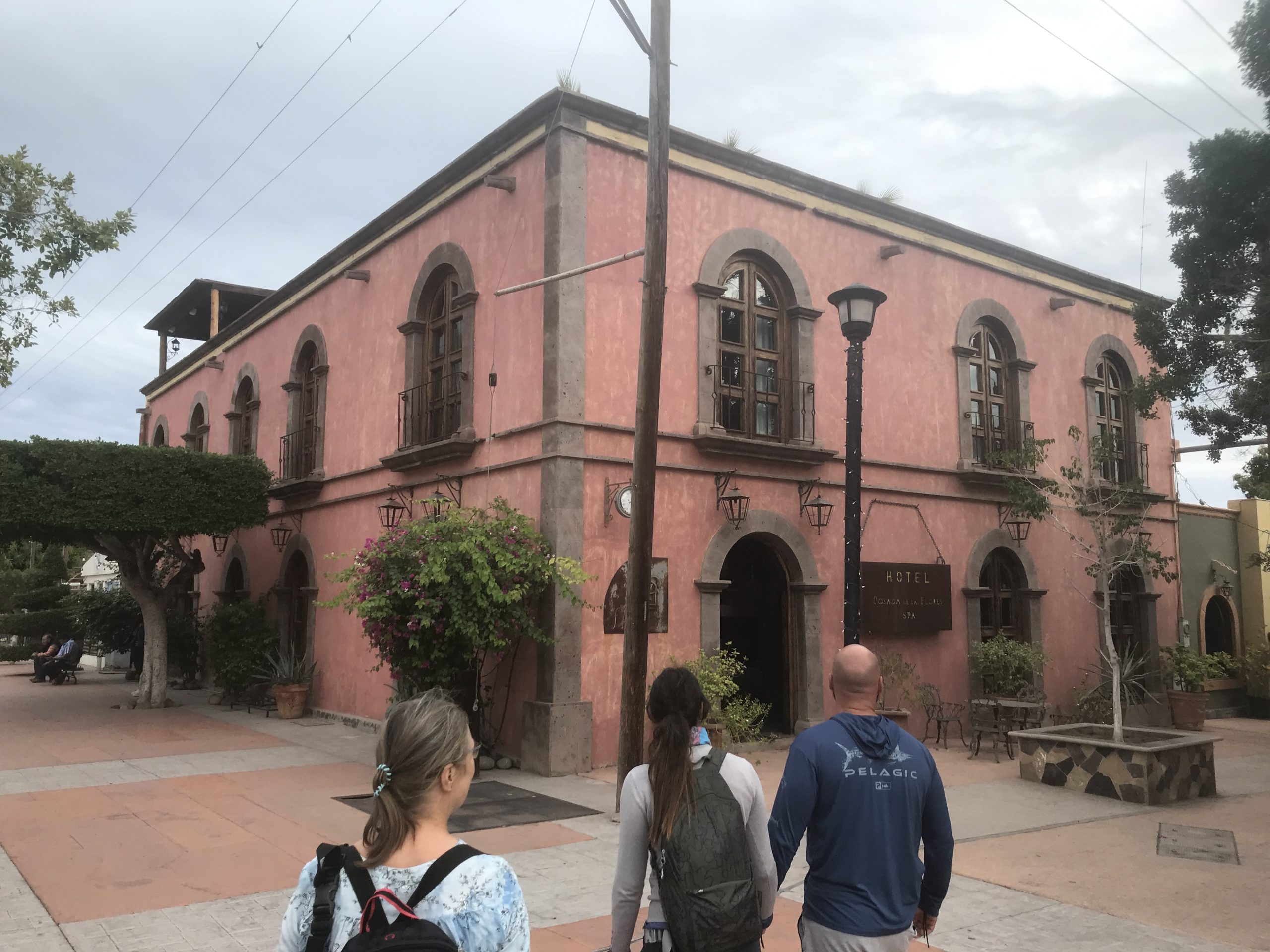






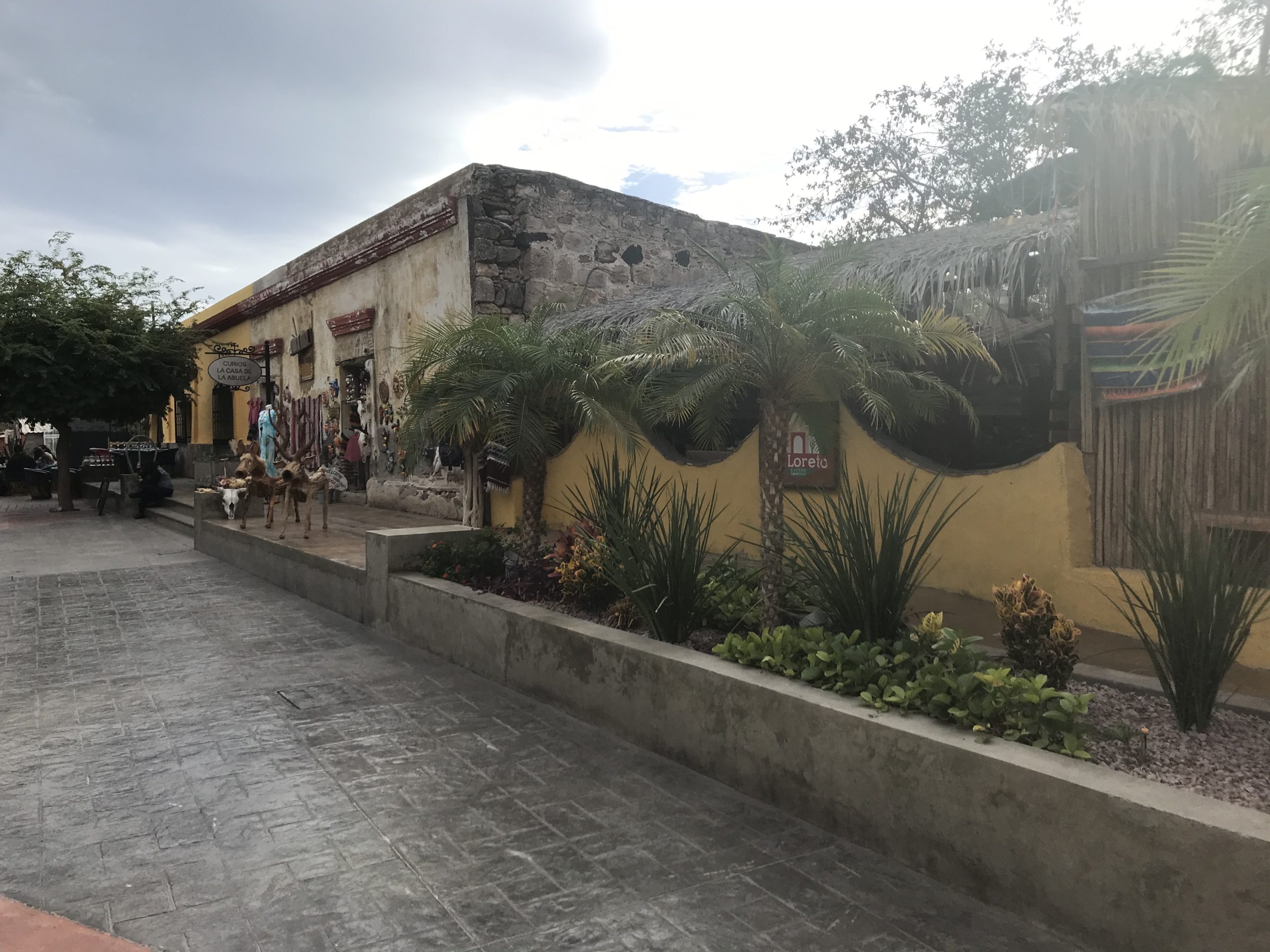
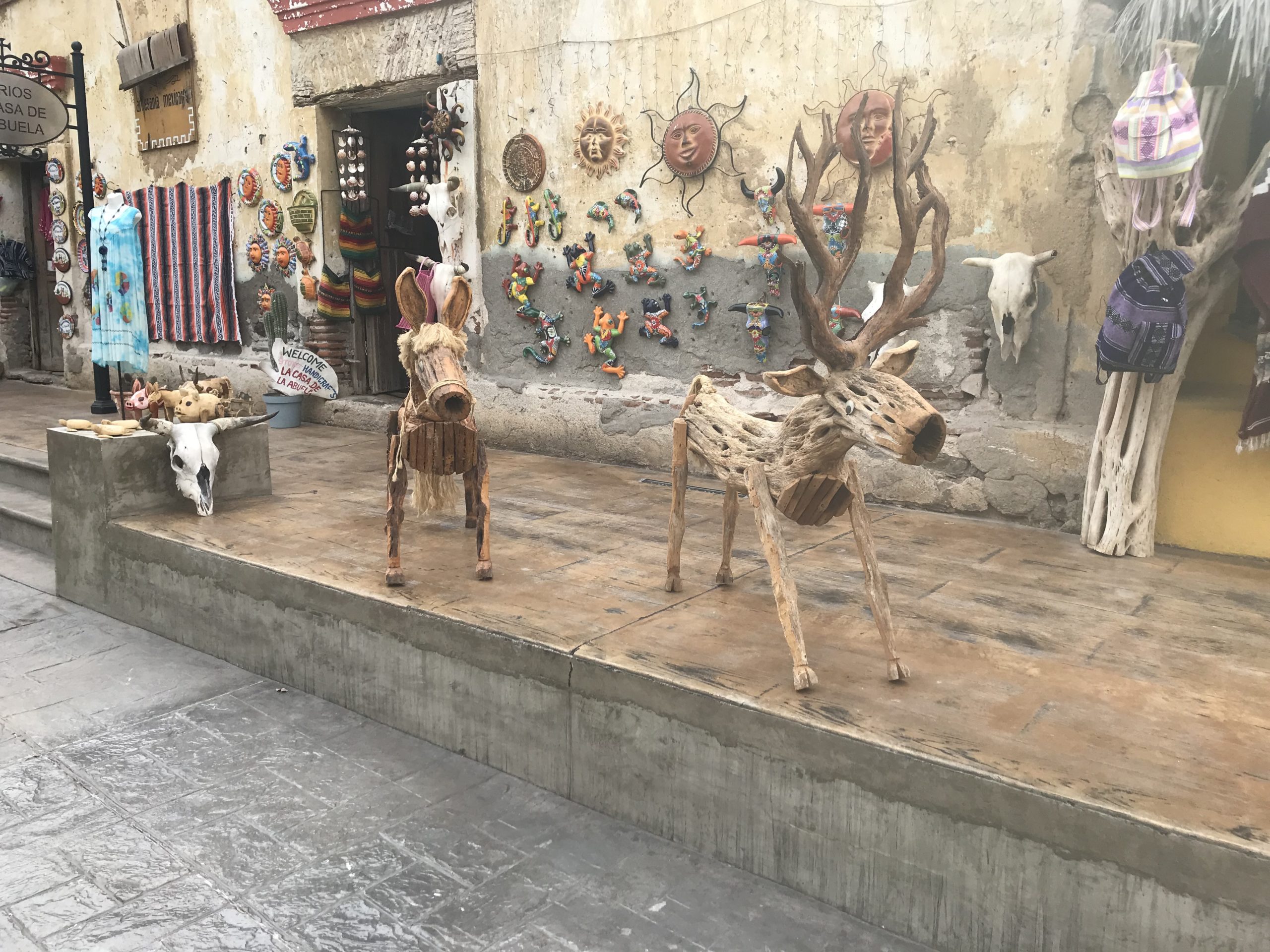


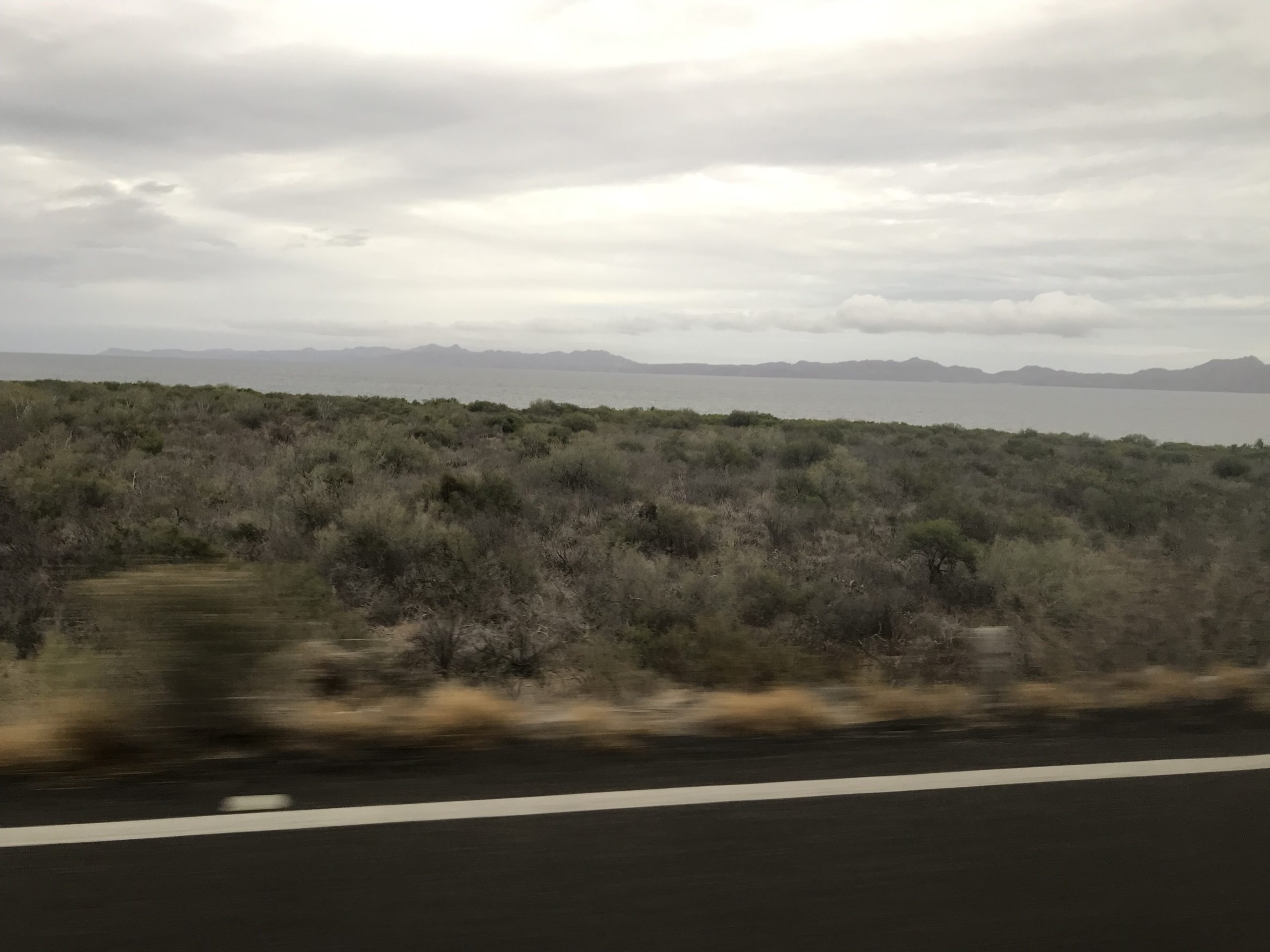

The Carry On wanted to continue to Santa Rosalia and we joined them. The route cannot be done in one day with the local wind conditions. We left early in the morning of 29th December, drifted for a while, partly under engine. It was not until noon that there was enough wind to make progress under sail. The weather already reminded us a little of summer on the Baltic Sea, the evening before it was rainy and the water dark grey. During the day there was sun, but the wind was cool to cold. Finally, I could wear a cap again while sailing 🙂 In general, light fleece jackets and our summer windbreakers as well as socks came out of the wardrobe. Yippee! The enormous heat has come to an end! 🙂



Around 6pm I get ready for bed on overnight trips, to get up again at midnight and relieve Mathias after an overlap time. From 6 p.m. onwards, the wind went completely to sleep and the SAN sometimes even drifted stern ahead in the current. Mathias was bored. Only after he lay down and I took over did the wind come back (the usual phenomenon 😉 ). With 5-7 knots of wind, we at least made progress again. It can sometimes happen that the boat gets out of control and turns into the wind. Then it’s easiest to get back on course with the help of engine support and afterwards turn the engine off again. I managed that quite well once, but the second time I got a bit confused. You steer by instruments at night and it’s not so easy to recognise the point at which you have to counter-steer so that the boat doesn’t swing too much. Such actions/movements make Mathias wake up immediately and so he was back at the helm at 6:20 am. Then it’s pointless to stay there any longer and I slept my second lap until about 10 o’clock. When I woke up, the wind had freshened to 10 knots, now coming more astern. We decided to get a spi out of the bow box again after more than a year. With a nice big red sail, we made good speed for quite a while.

5 nm before our destination, the wind shifted once more and we had to take down the sails to cover the last distance by motor. Shortly after sunset we arrived at Santa Rosalia. Since we didn’t want to enter an unknown harbour in the dark, we first anchored a little way down the coast. According to the guidebook, there were old sea cables in the water near the harbour. The night was ok. There were swells, but most of the time they weren’t too bad, only when an area of rain passed over us in the middle of the night, we were really shaken up. It woke me up, while Mathias slept through it. Honestly, he wakes up when I make gentle manoeuvres, but he sleeps through storms……
On 31 December, we entered the harbour in Santa Rosalia. There is a small marina where the Carry On was already moored at the T-jetty end. We looked for a place to anchor in the harbour where we could stay away from old sunken jetties and also not drift towards a sunken ship on the breakwater. The guidebook advised to leave the access to the navydock clear, but that no longer looked used. Given the size of the harbour, this meant keeping the chain to a minimum length. With the help of the app, we felt our way towards a still acceptable risk, where the chain would already pull the anchor at an angle, but would still be OK up to approx. 25 knots, always assuming the anchor ground would cooperate. In short, we brought out 44 m of chain. First shore leave was with the crew of the Carry On for lunch and then we walked along the main road towards the supermarket. On the way we could see the SAN from a different perspective and had the impression that she had drifted after all. So we quickly walked back towards the marina and over to the SAN. Everything was still alright, the danger only an optical illusion.




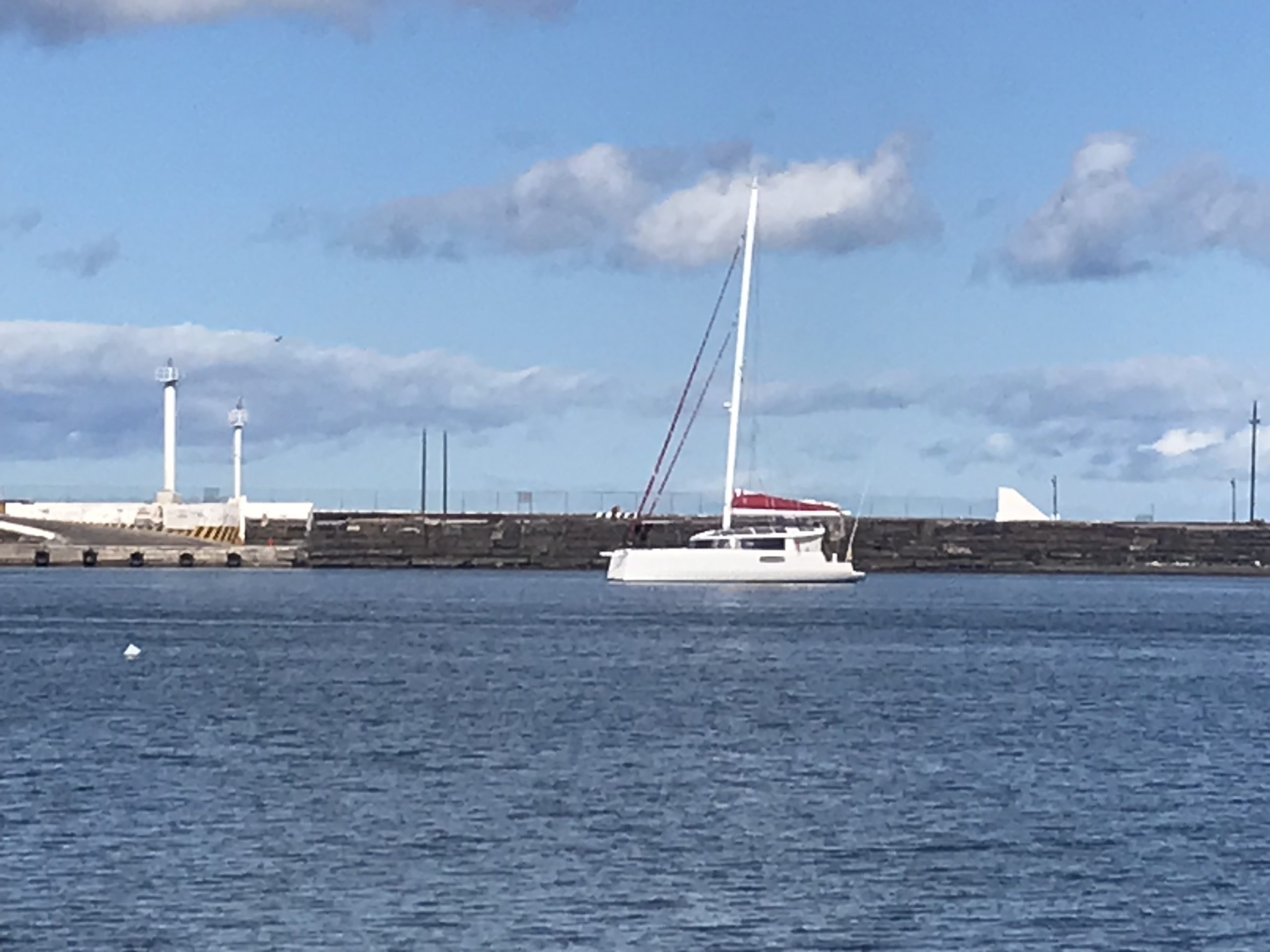
The town of Santa Rosalia is an old mining town. The French company El Boleo began mining copper in the area in 1885. The company operated under a tax-free 70-year concession until 1954. Now only some ruins of the old buildings remain and serve as a museum. One of the sights is a church (Iglesia Santa Barbara) built by Gustave Eiffel (the one with the tower in Paris) in 1884 in modular construction with cast iron plates and steel girders as a prototype for mission churches in French colonies. Eiffel exhibited the church in Paris at the 1889 World’s Fair, after which it ended up in a warehouse in Brussels. There it was discovered in 1894 by the director of the mining company, bought and transported around Cape Hoorn to Santa Rosalia, where it was put up in 1897.








It was New Year’s Eve and we went over to James and Eva’s again. We had already exchanged various New Year’s greetings with Germany and everyone was getting a bit sleepy on the Carry On – Sailors’ Midnight had to be used (9pm) and we were in bed by the real midnight. There were no fireworks either, only music could be heard from ashore all night long. This usually stops around 10 pm on normal nights.
On the first day of the new year, James and Eva had booked a flight to the USA. they wanted to renew their Mexican visa and also get vaccinated. It wasn’t clear whether you were allowed to fly out of the country without being vaccinated. For us, that meant keeping an eye on the two boats and looking after the Carry On dog. The dog is a very well behaved German shepherd named “Elbe”, but only 4 years old, so still full of energy. She is getting to know us and was therefore not irritated when we picked her up for a walk in the morning. On the contrary, Elbe gave the impression that she wanted to say: “Finally, what took you so long?” She immediately jumped onto the jetty and asked us to come along. First we went to the beach. It is famous because it is black and glistens. However, its best days are probably behind it. It looked more like it was only used to walk dogs. We threw stones for Elbe to chase and only left the beach when she showed signs of fatigue and ran into the water to cool off. After that, we went exploring the small town. Elbe, of course, still had enough energy left to persuade us to walk quickly.




The first thing we saw of Santa Rosalia from the anchorage was a sea of lights. The town looked bigger than expected and made a nice impression. Then we got to know the harbour with all its museum ruins, half-sunken jetty, sunken fishing boat and navydock that was no longer in use. It had made a run-down impression. As we walked through the streets, the place looked friendlier again. On New Year’s Day, most of the snack bars, restaurants and shops were closed. We wandered the streets and were most busy fending off the local dogs. They were all interested in the pretty female specimen that was walking with us…..



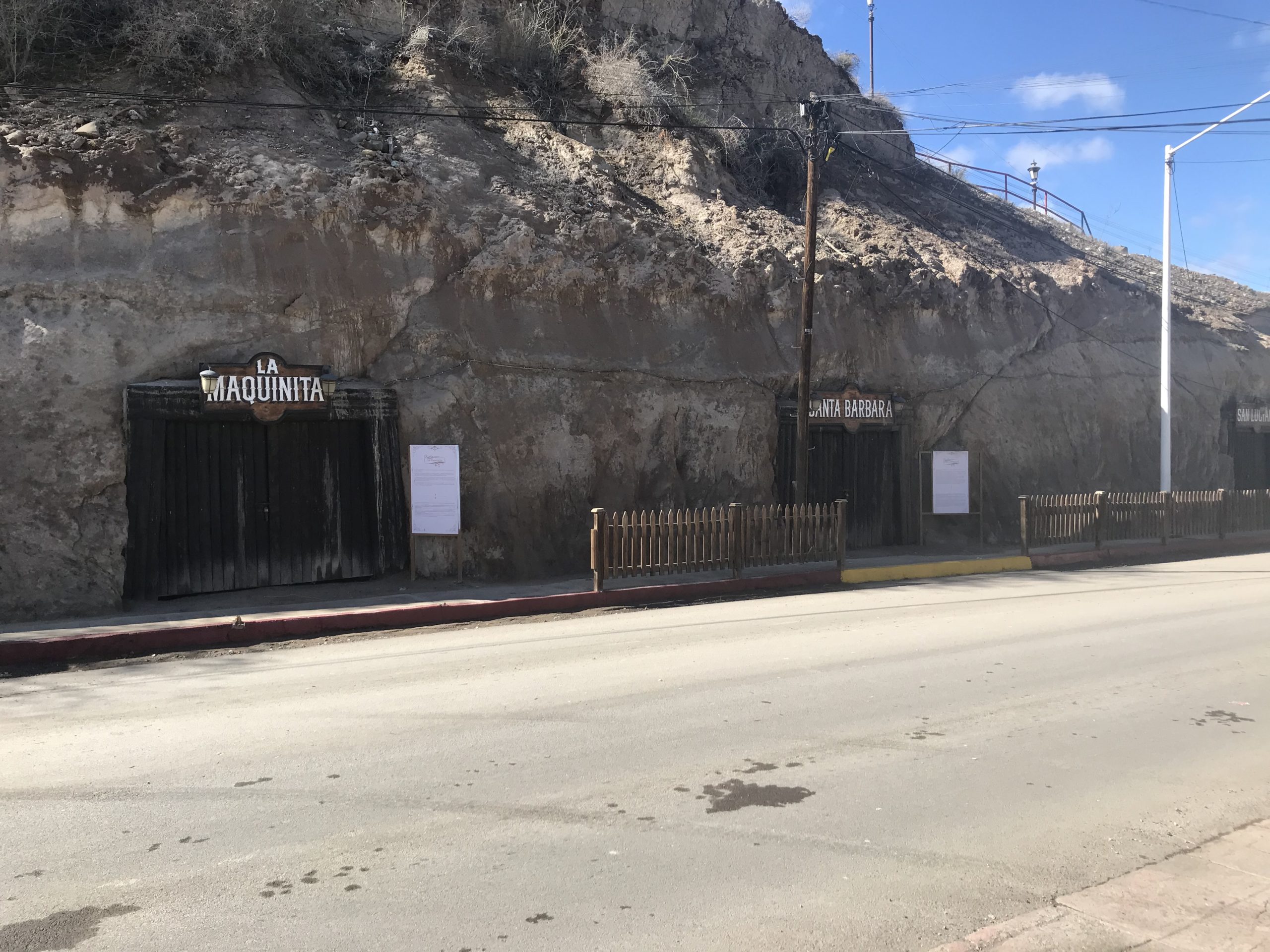


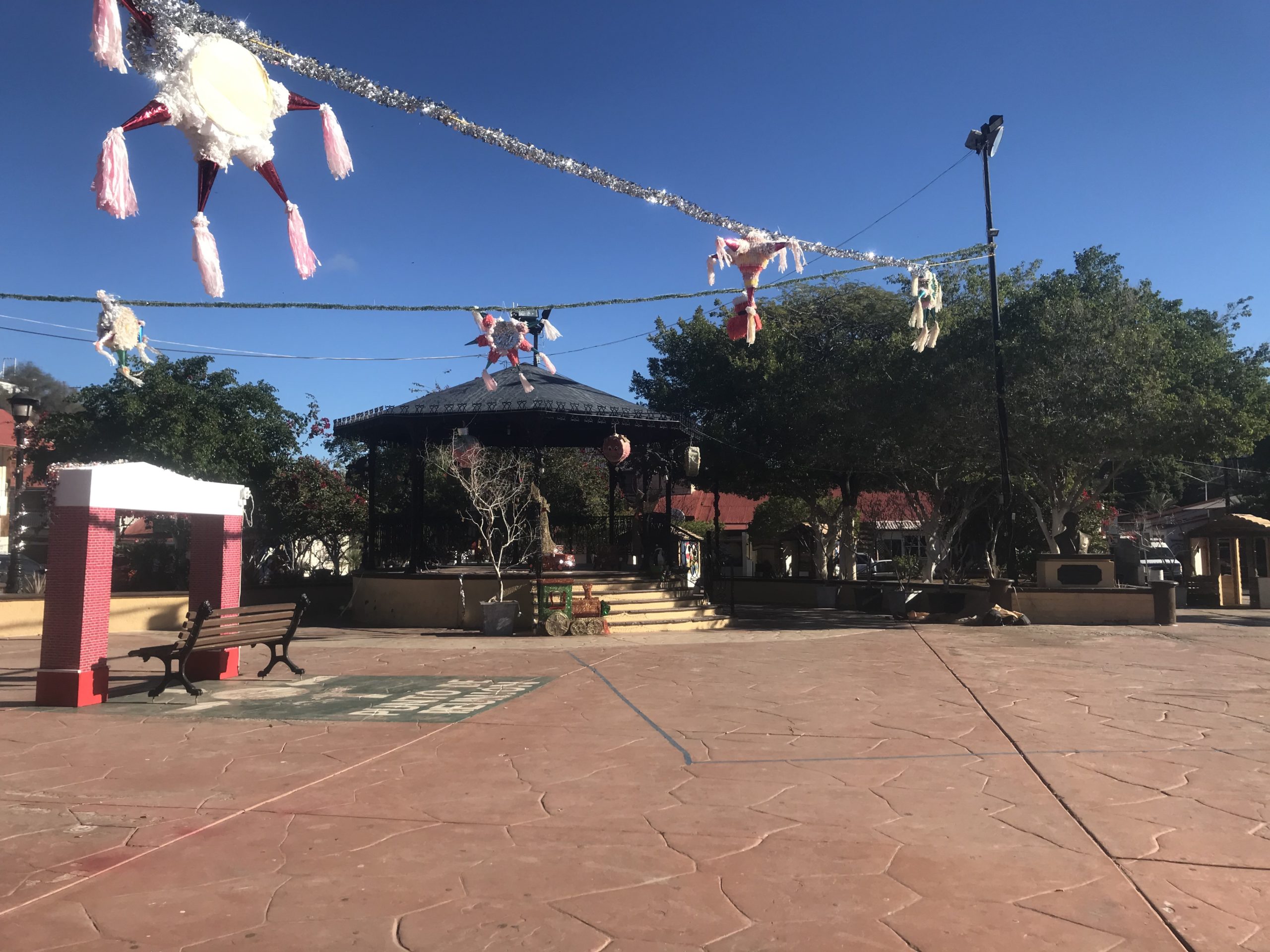



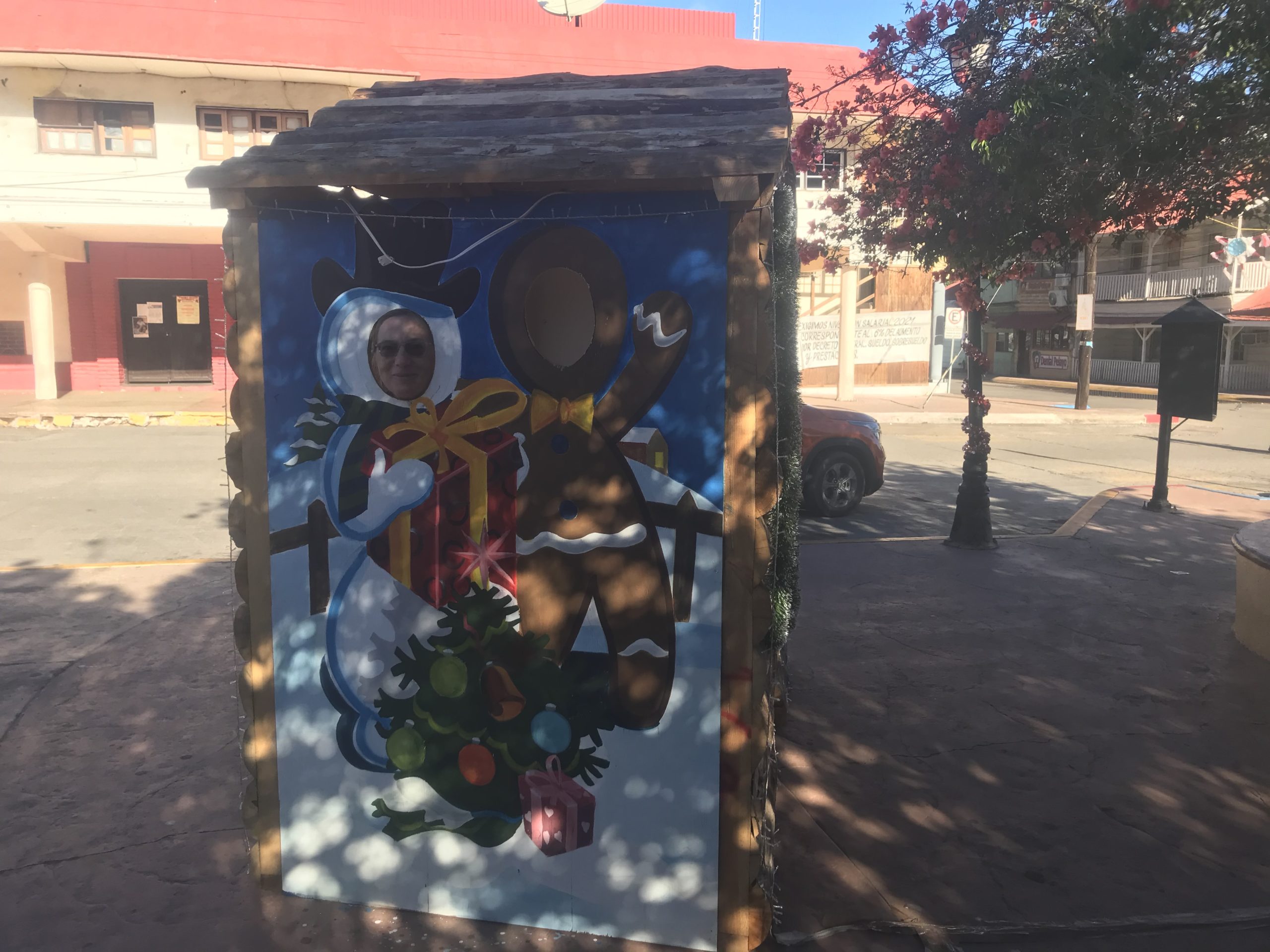



We found the church of Eiffel and after our round through the town we walked along the coastal road again to see where the big supermarket was. The dog had to be walked sufficiently, after all, we didn’t want to get into trouble with James.






We had got used to our dog-sitting function and were patting ourselves on the back for having mastered the day well. The two Carry On-lers had sent word that as they were unvaccinated they had not been allowed to get on the plane and were on their way back. So we were able to welcome them back on their own boat with cake shortly after our walk.
The following night there was much more wind, up to 38 knots in gusts. This was too much for the 44m chain, the calculated angle of pull at the anchor rose to 9.8 degrees, the bottom was muddy, the boat slipped. But because we knew that the chain was a bit short (to limit the swinging circle), we had set an anchor alarm. It rang us out of bed at around 4am. We had already slipped a bit (about 50 m) towards the harbour entrance. The nights here are cold, especially when there is a lot of wind. So first we jumped into our clothes, then to the helm, started the engine and tried to keep the boat on the spot. Too much speed is not good, because the harbour basin is narrow and you don’t want to run over the chain. Too little speed means you can’t steer and the wind pushes you around. On the track in the picture, you can see that we were dancing on the spot for a while. Time to think about what to do. Letting out more chain would have run the risk of us drifting into the sunken jetty if the wind direction changed. The marker light was already shining uncomfortably close diagonally behind us. The only thing left to do was to bring up the anchor and drop it again at the old spot with more chain. No sooner said than done. By now we are a well-rehearsed team when it comes to anchoring, so it went well even with a lot of wind. Of course there were no high waves in the harbour basin. After the excitement, we couldn’t go back to sleep and stayed on board the whole day as the wind kept blowing strongly. We now had 89 metres of chain out, the app did not calculate an angle at the anchor in 35 knots of wind. We were safe the whole day. The next day the strong wind was over and we were able to shorten the chain again to 65m this time. This gave us an acceptable schwinging circle. The navydocks were definitely no longer in use and the ferry either had a holiday break or was not sailing anymore either. Apart from us and the marina, the harbour basin was only used by small panga fishing boats that fished there in the early hours of the morning.






We dared to leave the boat again and went to the supermarket. Then we cleared the ship to start the journey across the Gulf of California to the Mexican mainland coast the following day. A trimaran doesn’t crank as much as a monohull, but with a lot of waves there are things that can fly off the surface and have to be stowed. Also, a certain amount of clutter tends to creep in at the anchor, which is more of a nuisance during the journey.
The destination was the Guaymas and San Carlos area. The marinas there were all full again. We got up before sunrise (cold, 15 degrees in the boat), lifting the anchor took a long time because the chain had to be cleaned of silt. The first stretch across the gulf we sailed with engine support because the wind started later. From 9 a.m. onwards, we were able to set full sail and made our way across to the other side at an average speed of 7.5 knots (max. 11.1 knots) in 14 to 17, max. 20 knots of wind. In the middle of the gulf (over 75 nm wide) you could see both coastlines. There are quite high mountains on both coasts. Just after sunset we reached the bay where we wanted to anchor and still had enough light to see what we were doing. The Carry On had left later, they had to anchor in the dark, but they were able to get their bearings from us and we had given them space. On the entrance to the bay we passed rocks from which loud barking could be heard. In the twilight, however, the brown seals were impossible to make out against the brown mountain backdrop.



Our strategy of anchoring first and entering the harbour the next day was also good this time. The entrance to Guaymas is buoyed and there is a lot of shipping traffic. The Carry On was already off when we got up and they had scouted out the harbour area. It is too shallow and the air has a permanent shrimp smell. So we turned around and tried our luck in the San Carlos area. Unfortunately it was a day with more wind and San Carlos is about 17 nautical miles north of Guaymas. This meant beating against the wind again. We tried a big beat out, the Carry On stayed close to shore. Further out, the waves were unpleasant and by the end of the second beat we had to get so close to the wind that it was no fun at all. Then the engine had to support. The highlight of the trip was the sighting of a seal swimming across close behind us. Mathias was not so pleased when he saw an orca that appeared in front of us and swam towards us. You want to avoid a collision.
At San Carlos we did not enter the harbour lagoon, but anchored in a bay next to it. Here you are protected from the north winds, and exposed to the swell when the winds blow from the south. At this time of year, the north winds are the worst winds, only light winds come from the south, so the bay is quite good for anchoring. It’s easy to get to the beach with the dinghy and there are only two of us here. When we arrived, however, there was a regatta going on. The boats didn’t care about us and cruised around in front of our bow, even though we didn’t have the impression of having sailed through the race course. Swerving at sea is always difficult, you can’t stop quickly and you can’t easily change course in any direction. First, a fishing boat overtook us without taking our course into account, and at the same time one came towards us and we were pinned down. Then the wild sailboats, where you could only see what they were up to at the last moment. We were glad when we hung on to our anchor. Even then, the boats were still passing close to the stern. Fortunately, the spook was over the next day.

The north winds here (Northers) have the same origin as the Santa Ana winds in California. They form when a high pressure system lies over the Great Basin, a huge plateau in the USA. The cold air masses then fall down the mountain sides, accelerate and sweep along the Gulf of California. The waves that spoiled our fun build up over the entire length of more than 1000 nm.


The town of San Carlos is a collection of apartment and hotel complexes. Then there is the marina and a boat dry storage. The buildings are Mexican style, most people are North American tourists. Internet in the bay is super fast. A trip to the marina first led us in the wrong direction. Freely following the motto: “The marina is where you can see all the masts”, we marched off, only to soon find that the marina was in the opposite direction. The masts belonged to a mass of sailboats in dry storage. 😉








We contacted the Volvo service because the turbo no longer works on both boats and asked about vaccination and booster options (or Eva did, as she is a native Spanish speaker). So the stay here could extend for a few days.

Mathias on his way to the Carry On with various electronic stuff. He found out why the Carry On’s AIS only worked erratically and didn’t have as long a range as ours. In the end it was due to a defective plug. It takes some detective work to diagnose that. In return, James helps us repair the turbo from the ship’s diesel. It’s good to be able to take care of everything on board yourself, but when you get help from friends who know better about some things, you’re glad. (As long as the friends don’t come across as know-it-alls. 😉 )
Change of plans: We will be off again. Vaccination is difficult for foreigners and takes place by age group. Spare parts have long delivery times. So we will have them delivered to the dealer at the next port we want to go to. Then we will most likely still be there before the spare parts.






